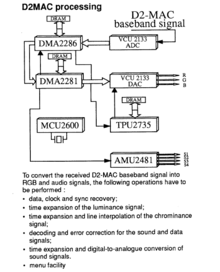D2-MAC

.jpg)

D2-MAC was created to solve D-MAC's bandwidth problem on European cable systems.
- D2-MAC uses half the data rate of D-MAC (10.125 Mbit/s)
- D2-MAC has a reduced vision bandwidth, about 1/2 that of D-MAC.
- D2-MAC retains most of the quality of a D-MAC signal—but consumes only 5 MHz of bandwidth.
MAC FAQ
MAC transmits luminance and chrominance data separately in time rather than separately in frequency (as other analog television formats do, such as composite video).
Audio and Scrambling (selective access)
- Audio, in a format similar to NICAM was transmitted digitally rather than as an FM sub-carrier.
- The MAC standard included a standard scrambling system, EuroCrypt, a precursor to the standard DVB-CSA encryption system.
History and politics
MAC was developed by the UK's Independent Broadcasting Authority (IBA) and in 1982 was adopted as the transmission format for the UK's forthcoming direct broadcast satellite (DBS) television services (eventually provided by British Satellite Broadcasting). The following year MAC was adopted by the European Broadcasting Union (EBU) as the standard for all DBS.
By 1986, despite there being two standards, D-MAC and D2-MAC, favoured by different countries in Europe, an EU Directive imposed MAC on the national DBS broadcasters, to provide a stepping stone from analogue PAL and Secam formats to the eventual high definition and digital television of the future, with European TV manufacturers in a privileged position to provide the equipment required.
However, the Astra satellite system was also starting up at this time (the first satellite, Astra 1A was launched in 1989) and that operated outside of the EU’s MAC requirements. Through the 1990s, a battle raged between the proponents of PAL on Astra and MAC on the DBS satellites. Despite further pressure from the EU (including a further Directive originally intended to make MAC provision compulsory in TV sets, and a subsidy to broadcasters to use the MAC format), the broadcasters and viewers preferred the ease and lower cost of PAL equipment and voted with their dishes, choosing the pan-European PAL broadcasts of Astra over the national DBS satellites.
By the mid-1990s, the unexpectedly rapid rise of digital broadcasting technology rendered the arguments irrelevant, and the use of D-MAC and D2-MAC faded away.[1]
See also
- Analog high-definition television systems
- PAL & SECAM
- Multiplexed Analogue Components
- DVB-S & DVB-T
References
- ↑ High Above Broadgate Publications (April, 2010).
External links
- Multiplexed Analogue Components in "Analog TV Broadcast Systems" by Paul Schlyter